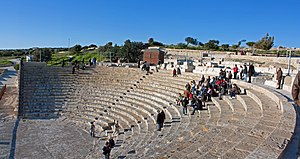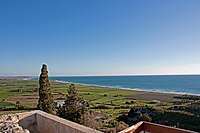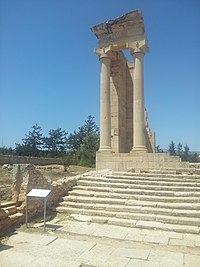Kourion: Difference between revisions
Created page with "right|thumb|300px|Kourion Theatre {{county|Akrotiri and Dhekelia}} '''Kourion''' ({{lang|el|Κούριον}}) is an ancient city, l..." |
mNo edit summary |
||
| Line 7: | Line 7: | ||
Kourion is close to the south shores of the island to the west of the river ''Lycus'' (now called Kouris). The Late Roman map known today as the ''Tabula Peutingeriana'' shows Curium to lie 16 Roman miles from Amathus, the ancient royal capital of Cyprus.<ref>[http://peutinger.atlantides.org/map-a/ Tabula Peutingeriana]</ref> It was recorded by numerous ancient authors including Ptolemy, Stephanus of Byzantium, Hierocles, and Pliny the Elder. | Kourion is close to the south shores of the island to the west of the river ''Lycus'' (now called Kouris). The Late Roman map known today as the ''Tabula Peutingeriana'' shows Curium to lie 16 Roman miles from Amathus, the ancient royal capital of Cyprus.<ref>[http://peutinger.atlantides.org/map-a/ Tabula Peutingeriana]</ref> It was recorded by numerous ancient authors including Ptolemy, Stephanus of Byzantium, Hierocles, and Pliny the Elder. | ||
Today the site lies within the British jurisdiction of the Western Sovereign Base Area but it is maintained and | Today the site lies within the British jurisdiction of the Western Sovereign Base Area but it is maintained and administered by the Republic of Cyprus according to the 1960 Treaty of Establishment.<ref>[http://www.mfa.gr/images/docs/kypriako/treaty_of_establishment.pdf Treaty of Establishment], 1960,"Antiquities",p.112,p116''</ref> On 5 July 2012, when Cyprus took up the six-month presidency of the European Union, it held a ceremony to mark the event in the ancient theatre of Kourion.<ref>[http://www.theguardian.com/world/2012/jul/04/cyprus-eu-presidency-europe-crisis The Guardian, 4 July 2012]</ref> | ||
==History== | ==History== | ||
Revision as of 06:03, 22 April 2015

Kourion (Greek: Κούριον) is an ancient city, long abandoned but lovingly excavated, in the southern plain of Cyprus, within the Western Sovereign Base Area of Akrotiri and Dhekelia.
Kourion throve during the Roman Empire. It is known as Curium ("Court") in Latin and appears as Curias in the writings of Pliny the Elder (v. 13). The city endured from antiquity until the early Middle Ages.
Kourion is close to the south shores of the island to the west of the river Lycus (now called Kouris). The Late Roman map known today as the Tabula Peutingeriana shows Curium to lie 16 Roman miles from Amathus, the ancient royal capital of Cyprus.[1] It was recorded by numerous ancient authors including Ptolemy, Stephanus of Byzantium, Hierocles, and Pliny the Elder.
Today the site lies within the British jurisdiction of the Western Sovereign Base Area but it is maintained and administered by the Republic of Cyprus according to the 1960 Treaty of Establishment.[2] On 5 July 2012, when Cyprus took up the six-month presidency of the European Union, it held a ceremony to mark the event in the ancient theatre of Kourion.[3]
History


Kourion was said to have been founded by the Argives.[4][5] Legend states that Stesenor, its sovereign, betrayed the cause of his country during the war against the Persians.[6]
Near the town was a cape[7] from which sacrilegious offenders who had dared to touch the altar of Apollo were thrown into the sea.[8]
The city has passed through different phases spanning the Hellenistic, Roman, and Christian periods. For this reason the city has a very large agora (market place). An early Christian basilica can be found within the city walls. Furthermore, large public baths which were equipped with cold, warm and hot spas were built. The large amphitheater sits 2000 spectators and held mostly gladiator games, therefore in the city there is Palestra or a training place for gladiators. The whole city has beautiful floor mosaics, but the majority are found in the house of Achileas and the private bath of the founder of the city.
Two miles from the city is the sanctuary of Apollo Hylates, which has stunning Cypro-Corinthian columns. On the same location there exists a place of worship for a woodland god dating back to 6000 BC. In between Kourion and the sanctuary of Apollo a stadium that is around 450 yards long is found; this stadium could sit up to 7,000 spectators who would watch ancient Greek sports.
The city, for all its magnificence and confidence, is believed to have been destroyed in the 4th century when a series of five strong earthquakes hit the city in a period of 80 years.[9]

Bishopric
The Greek Orthodox menologium mentions a bishop of Curium who was severely tortured under the Roman emperor Licinius, but survived to live under Constantine the Great. Among the members of the Council of Ephesus in 431 was a Bishop Zeno from Curium.[10][11] No longer a residential bishopric, Curium is today listed by the Roman Catholic Church as a titular see.[12]
Ruins

The ruins of Kourion, near the modern town of Episkopi, are is located on one of the most fertile spots in the island,[13] with extensive ruins and including well-preserved mosaics. Also of interest are the public baths, the necropolis, the Fountain House, House of Gladiators and House of Achilles. The most spectacular site at Kourion is the Greco-Roman theatre, or forum (pictured), that has been completely restored (with the Mediterranean as a backdrop) and is used today for open air musical and theatrical performances. It is one of the venues for the International Festival of Ancient Greek Drama.[14]

Many artifacts were removed from Kourion by the notorious treasure hunter, Luigi Palma di Cesnola, in the late 19th century who served as Consul to Cyprus for the United States. These were transported to the United States, where they formed the bulk of the first exhibition of the New York Metropolitan Museum of Art.[15] Some are still on exhibition today.[16][17] Thousands of other pieces however were sold to Stanford University, rescued from the ruins of the earthquake-buried city, only to be destroyed by the great earthquake that hit California in 1906.[18] A third portion of this collection ended up at the Semitic Museum at Harvard University.[19]
Excavations were also conducted by several other expeditions. The British Museum enriched its Cypriot artifact collection through excavations conducted during the British occupation of the island between 1893 and 1899.[20] The excavations on the theatre were carried out by the University Museum of Philadelphia.[21] Works began in 1934 and were completed in 1949.[22]
Paragliding
Kourion is a major paragliding site in Cyprus and is flyable on most days of the year. Many pilots from all over Cyprus and visitors to the island use the area as a launching spot.
Outside links
| ("Wikimedia Commons" has material about Kourion) |
- Kourion by Department of Antiquities of Cyprus
- Kourion by Limassol Municipality
- Panoramic views of Kourion
- The Cesnola Collection from Ancient Cyprus
- The Curium Soaring Club of Cyprus
- Paragliding Cyprus
References
- ↑ Tabula Peutingeriana
- ↑ Treaty of Establishment, 1960,"Antiquities",p.112,p116
- ↑ The Guardian, 4 July 2012
- ↑ Herodotus Book 5: Terpsichore - see Herodotus
- ↑ Strabo, Book 14, 6.1.3 - see Strabo
- ↑ Herodius l. c.
- ↑ Φρούριον, Ptolomy v. 14. § 2
- ↑ Strabo l. c.
- ↑ The Day the World Ended At Kourion, National Geographic: July 1988, Vol.174, No. 1, p.30-53
- ↑ Michel Lequien, Oriens christianus in quatuor Patriarchatus digestus, Paris 1740, Vol. II, coll. 1057-1058
- ↑ Pius Bonifacius Gams, Series episcoporum Ecclesiae Catholicae, Leipzig 1931, p. 438
- ↑ Annuario Pontificio 2013 (Libreria Editrice Vaticana 2013 ISBN 978-88-209-9070-1), p. 877
- ↑ Richard Pococke, Trav. vol. ii. p. 329; Engel, Kypros, vol. i. p. 118.
- ↑ Cyprus Centre of International Theatre Institute site
- ↑ "Permanent Collection - Highlights". The Metropolitan Museum of Art.. http://www.metmuseum.org/Works_of_Art/viewOne.asp?dep=13&viewmode=0&item=74%2E51%2E4554§ion=description#a. Retrieved 2007-03-26.
- ↑ The Eastern Mediterranean: 1000 B.C.–1 A.D. Metropolitan Museum
- ↑ The Eastern Mediterranean: 2000–1000 B.C. Metropolitan Museum
- ↑ Cesnola Collection at the Semitic Museum at Harvard University
- ↑ The Cesnola Collection from Ancient Cyprus
- ↑ "Department of Greek and Roman antiquities (collection's history)". British Museum. http://www.thebritishmuseum.ac.uk/gr/grcoll_4.html. Retrieved 2007-03-25.
- ↑ Benson, J. L. (October 1956). "Spirally Fluted Columns in Cyprus". American Journal of Archaeology 60 (4): 385–387. doi:10.2307/500877.|url=http://links.jstor.org/sici?sici=0002-9114%28195610%2960%3A4%3C385%3ASFCIC%3E2.0.CO%3B2-J&size=LARGE%7Cformat=%7Caccessdate=2007-03-26
- ↑ Stillwell, Richard (February 28, 1961). "Kourion: The Theater". Proceedings of the American Philosophical Society 105 (1): 37–78.
Coordinates: 34°39′51″N 32°53′16″E / 34.6642°N 32.8877°E
